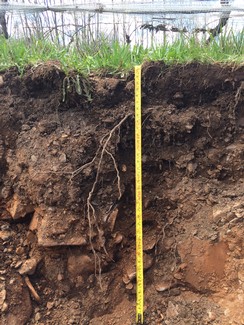L'Acadie Vineyards Blog
Welcome to the L'Acadie Vineyards blog and winery news
2024 Harvest Summary
2024 Harvest Summary via Instagram
A harvest update from winemaker Bruce Ewert for our Gaspereau vineyard in Nova Scotia, Canada. Our estate winery near Wolfville makes certified Biocyclic Vegan and organic sparkling wines and this year we harvested Sauvignon Blanc for a Sancerre-style wine to be released in 2025.
2024 Harvest Update
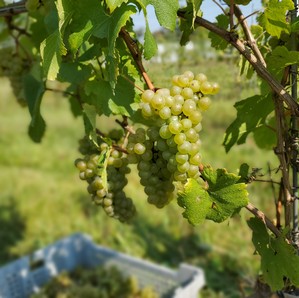
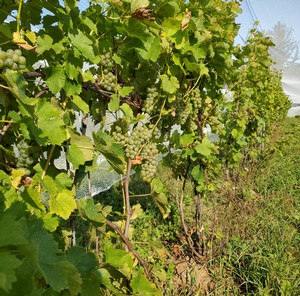
Chardonnay and Sauvignon Blanc 2024 at L'Acadie Vineyards, Gaspereau, NS
Harvest 2024 is halfway done and quality and freshness are head turning! We started picking September 16, our earliest harvest ever, and it reminds me of 1998 in the Okanagan Valley when I was winemaker at See Ya Later Ranch winery. That was the earliest harvest for British Columbia wineries at that time too and marked beginning signs of climate change. Here at L'Acadie Vineyards near Wolfville we watch acidity (freshness) closely by sampling grape maturity leading up to harvesting vineyard blocks and have always maintained freshness for close to twenty vintages, the benefit of having our Nova Scotia winery in such an ideal cool climate for sparkling wine.
2024 marks a rebound year from the 2023 polar vortex in Nova Scotia. Pictured above is organic & Biocyclic Vegan Chardonnay and Sauvignon Blanc planted in 2019. These varieties are far more sensitive than other varieties that we grow at our Gaspereau vineyard, so harsh winter weather can have devastating effects. Last year and this year we meticulously trained new trunks and interplanted where vines had died. We are so excited and grateful to have a beautiful small-lot harvest from our estate Chardonnay, Sauvignon Blanc and Pinot Noir this year. 🍇✨
Growing grapes on the limits of cool climate viticulture can have risks such as winter damage, but rewards in quality can often surpass world wine standards. Fingers crossed this will be another award winning vintage!
Related blogs,
/blog/Vineyard-Update---Polar-Vortex-Impact
/blog/Update-from-the-Vineyard
~~~~~~~
Thanks for supporting farm wineries in Nova Scotia! These are challenging times with government and we appreciate your support. https://www.cbc.ca/news/canada/nova-scotia/wine-grape-growers-tim-houston-vineyards-1.7333355
Update from the Vineyard - late summer
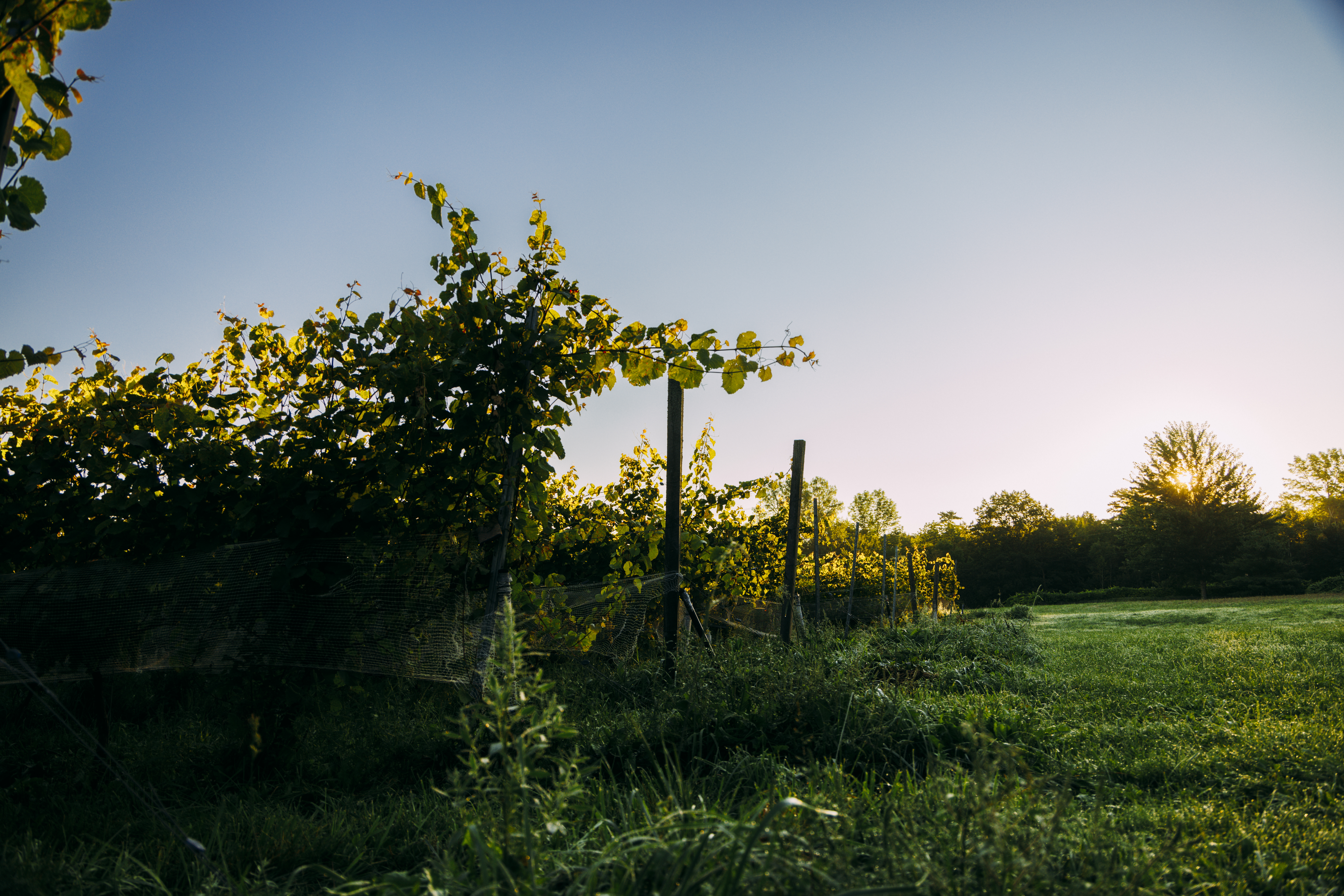
Celebrating 20 years since moving back to Nova Scotia this year, and next year 20 years since planting for sparkling on our rocky soil. This harvest will be extra special as we slide into late summer putting up nets and final tweaking crop levels. It has been a great growing season except for high mildew pressures with rains and humidity but our organic practices have controlled it and our well-drained soil handled those +100mm rain events. Even planning on over-the-row netting for Sauvignon Blanc and Pinot Noir this year! (wine club members will be excited for more small lots)
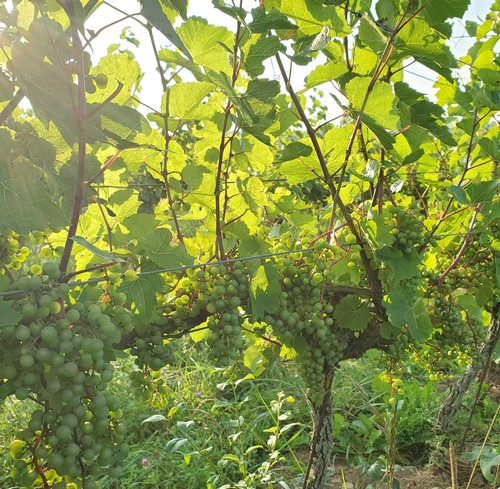
Read blog about why we chose our rocky vineyard 20 years ago, Discovering Rocks
We planted more Seyval Blanc this year mainly for Tidal Bay and interplanted Pinot Noir, Sauvignon Blanc and some Chardonnay to replace vines from the polar vortex last year. Wine club members have been enjoying 2021 sparklings from first harvests of these blocks. Vineyard supervisor Chris planted cilantro and dill at end posts to attract phylloxera predators and we hope to try sweet alyssum next year recommended by our friends at Biocyclic Vegan.
Beautiful time to visit our winery near Wolfville. Book a guided tasting
Sante,
Bruce
Planting estate Seyval Blanc
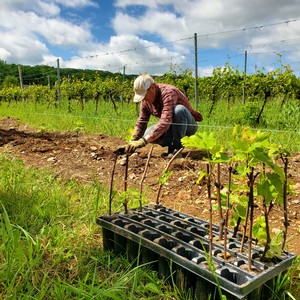
As many of you know, we established L'Acadie Vineyards in Gaspereau Valley in 2004 and started planting in 2005 with exclusively L'Acadie Blanc for organic sparkling wine. This decision has stood the test of time with numerous international awards for our Estate Prestige Brut from those first blocks, a classic terroir/style matching success. We later planted Leon Millot for our appassimento red program, Chardonnay, Pinot Noir and Sauvignon Blanc. This year we planted more Seyval Blanc, adding to our interplanted Seyval vines in a L'Acadie Blanc block, to bring citrusy zing notes to our Tidal Bay blend. Read about the Nova Scotia winery appellation Tidal Bay.
Here's a little background on Seyval Blanc,
- citrus and zingy acidity - used for sparkling in England, also in Finger Lakes region of New York and Oregan.
- early ripener, good producer and suited to cool climates
- a hybrid grape, bred in France by plant breeder Bertille Seyval
Read more on Wikpedia, Seyval Blanc. And here's a short video watering the new vines.
Vineyard Update June 2024
After several years of extreme weather, 2024 is tracking to be a welcomed “normal” growing season for Nova Scotia’s Gaspereau Valley wine region. Winter temperatures were mild and did not damage buds like the polar vortex of 2023. And spring frosts were a distant memory. We certainly learned from the spring frost of 2018 though and this year left a kicker cane on each vine – an extra cane to delay budbreak and for “insurance”, and we are currently pruning them off now that frost danger is gone.
All this adds up to our estate vineyard looking esthetically pleasing and poised to give us incredible grapes for its 19th year! More wood than ever before had to be pruned off this year from the effects of polar vortex bud killing, so we bought ourselves a more powerful mulching mower to return nutrients back to rows. Chris, our vineyard supervisor, has been mechanically weeding under vines with our Clemens grape hoe and preparing end of rows for planting cilantro to attract insect predators, part of a biodiversity component of our Biocyclic Vegan certification. Horsetail tea will be harvested this week for brewing, one of our organic practices to protect vines from mildew disease.
Take a vineyard tour with vineyard supervisor, Chris. Click here
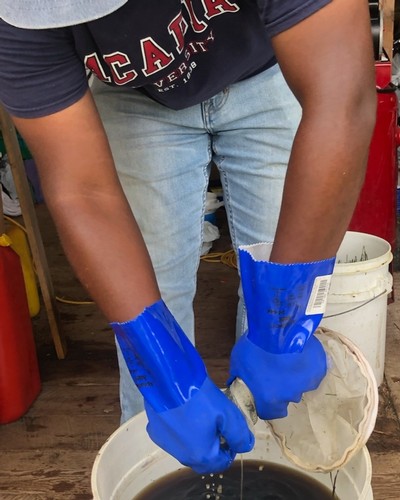
Horsetail Tea preparation
Lower blocks of Chardonnay, Sauvignon Blanc and Pinot Noir were hit hard in winter 2023 but luckily many vines grew new trunks from the lower graft union. Not much pruning was required this year, only tying these precious canes to the fruiting wire. The vines with severe winter damage will be replanted this spring and next spring, and delivery of Pinot Noir vines from the nursery should be next week.
~ Bruce
Update from the Vineyard
Climate change continues to impact wine regions across Canada, more recently in British Columbia’s Okanagan Valley with record January lows of -28C wiping out possibilities of any crop this year. Nova Scotia had a comparatively less severe polar vortex in February 2023 and the main difference in impact is due to BC’s plantings of sensitive vinifera grape varieties compared to our region’s predominantly hybrid varieties. At least we had crop from L’Acadie Blanc and Leon Millot last year, reasonable yields from our certified organic and biocyclic vegan Gaspereau vineyard, but young vinifera Chardonnay and Pinot Noir got hit hard and vineyard practice has to be focused on renewal for future years by carefully training new trunks.
Read CBC article Cold snap causes catastrophic loss for BC's wine industry
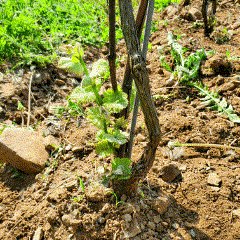
Chardonnay new shoots in May 2023 after polar vortex: L'Acadie Vineyards
Happy to report that we don’t expect any winter damage this year after a fairly mild January and February. It’s still early to clink glasses together and we’ll wait until threats of late spring frosts are over – a spring frost/freeze in 2018 impacted our inventories of aged sparkling wine. The vines do not need another year of stress and we continue to inspect for signs of damaged trunks from the polar vortex.
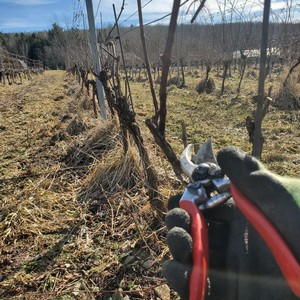
Pruning started on Leon Millot and L’Acadie Blanc and we are leaving 3-4 fruiting canes - one as a kicker cane to delay budbreak, to be removed after spring frosts are over. Chardonnay and Pinot Noir and our coveted little planting of Sauvignon Blanc will need minimal pruning as we train new shoots/trunks... and possibly get a very small crop this year. Perhaps we’ll toast with a glass of our upcoming new first release of 2021 Sauvignon Blanc traditional method sparkling!
Read a related blog, Climate change and organic farming
Year in review 2023
Year in Review - 2023 curveballs
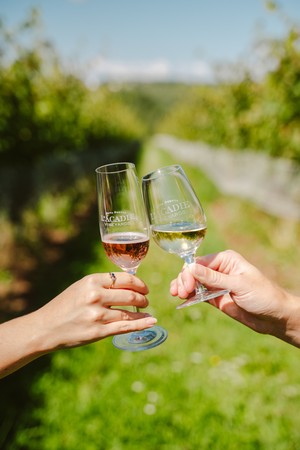
Mother Nature threw many curve balls at us this year. We are thankful on many fronts and perhaps most promising are the early indicators of resilience from farming our Gaspereau vineyard organically.
The polar vortex in February reduced our viable buds and we adjusted our pruning and other cultural practices. L'Acadie Blanc and Leon Millot had reasonable yields but not so with Chardonnay, Pinot Noir and Sauvignon Blanc. Hopefully new trunks that we carefully nurtured this year will give us good growth next year in these vinifera blocks. There was some vine loss with these more cold sensitive varieties but not nearly as much as we anticipated and perhaps attributed to deep reaching roots in our gravelly soil coupled with living organic soils rewarding us with a measure of early resilience in these young blocks.
Read our blog about climate change resilience from living soils
Then the rains came. The resulting high mildew pressures were very risky all summer and our organic viticulture was put to the test! Happy to say that we avoided significant diseases with the great work from our new vineyard supervisor, Chris.
See video of Chris explaining our organic and vegan vineyard practices,
Harvest started September 21 and we couldn't have been happier with finally getting dry, warm, shorts and t-shirt weather. And good timing for flavour development too! Everything was hand picked and whole cluster pressed with a gentle sparkling press program for best quality juice. The only exception to this daily routine was L’Acadie blanc fermented on its skins for our next release of Orange Wine coming from our Gaspereau winery in the spring.
The iconic signature in Nova Scotia didn't waver even with all the curveballs - consistent ripe grapes with great acidity and moderate sugar levels. We see it every year, no compromises, and it is this significant attribute of our cool climate that constantly validates our emerging sparkling wine region. Look for structured, lower alcohol and refreshing sparklings in future releases, and a dry crisp whites in the spring!
We earned many wine awards this year with Prestige Brut Estate and Vintage Cuvee leading our portfolio with golds from Decanter World Wine Awards and National Wine Awards of Canada, respectively. Very thankful for media attention and accolades for the first Decanter gold ever for Nova Scotia, throwing a spotlight on organic vegan wine quality.
Read our blog about Gold at Decanter World Wine Awards and Decanter's article Canada Calling: The wines exciting the experts now
Winter solstice resets our thoughts to reflect and calm as we plan the new season, the new cycle of life, for our 20th year. Very grateful.
~Bruce, owner winemaker
Sustainable Wine - how far have we come?
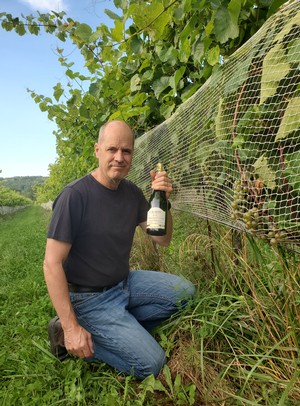
How far have we come? Sustainable wine may sound like a buzzword created by corporate wine executives to sell more wine and give impressions that all wineries must already subscribe to the concept because it's repeated in marketing so much and seems attainable but there remains a large gap between wine producers. You’d think the wine industry would have progressed the most since the beginnings of the environmental movement in the 1960’s, their marketing is so visible, seductive and competitive. But like climate change, microplastics and bee colony collapse there continue to be issues that our society has been slow to understand and act on. Why aren’t we more advanced? The alarm sounding, environmental catalyst classic Silent Spring by Rachel Carson was published in 1961 and the culture at the time was that synthetic insecticides will save the world. Her dystopian outlook for the environment affected by these persistent chemicals such as DDT threatened that culture and she was attacked and muffled by stakeholders and the misinformed. Scenarios repeated time and time again for the last 60 years.
Wine, the beverage of ingredients. If mother nature doesn't provide during the growing season, well there’s an ingredient for that. And the range is great – Mega Purple for colour, potassium sorbate for stability, crushed chestnuts for more tannin, gelatin for less tannin, citric and tartaric acids for more acidity, potassium bicarbonate for less acidity, even ethanol for more alcohol, and water for less alcohol. There are animal inputs like egg whites, gelatin, milk protein, and synthetic inputs like PVPP (plastic) and a broad range of synthetic pesticides. I introduce vineyard inputs here because whatever is added to the vineyard ends up in your glass as residual chemicals. Similar to Silent Spring’s explanation of the relationship of aerial spraying DDT on Elm trees and the residue on leaves killing robins via earthworms. Many pesticides are systemic, they protect the vine from within by being absorbed into tissues, vascular system and berries, and even contact pesticides are absorbed into the plant, like our skin absorbs. Most provincial liquor boards require a pesticide residue analysis before listing a wine because there are limits set. Limits that are recognized to be safe doses, not carcinogenic. But pause here and think about the last 60 years and how we seem to have learned so little. The World Health Organization (WHO) classified Roundup, a too common glyphosate weed killer used in vineyards, as probable carcinogen but changed it to possible carcinogen in the 80's after chemical industry lobby pressures. It is now back to probable carcinogen.
Read Organic diets quickly reduce the amount of glyphosate in people's bodies
Raise your hand if you are interested in sustainability. In protecting our precious environment and your health, and your community’s health. Brock University recently conducted wine research: An Exploration of Consumer Perceptions of Sustainable Wine. Over 700 people surveyed.
“Consumers with high involvement in sustainable wines tend to be younger, better educated, more involved in wine in general, and spend more per bottle than those with low involvement.” Pickering, Best, 2023
“Results show that sustainability-related cues are somewhat valued by consumers when making purchase decisions, but have low importance relative to the other cues examined. Environmental dimensions of sustainability have high saliency, in contrast with social and economic dimensions, and a significant minority of respondents report no or very limited knowledge of sustainable wines.”
There is change happening and it is generational – millennials and Gen Z are leading consumers. In Europe the changes are most apparent. Spain’s Denomination of Origin Penedès in Catalunya (DO Penedès) recently announced an extensive roadmap up to 2030, taking into account sustainability and establishing the region as a high-quality wine producer in Spain. Most immediately, all grapes for DO Penedès wines must be from fully-certified organic vineyards by 2025.
Full article: DO Penedes Organic Wine Plans by Decanter
European government funding for vineyards is based on level of sustainability, with certified organic being king. And as noted, quality is a large motivator for this Spanish region. Climate change resilience is a benefit too with cover crops, diversity and minimal tillage protecting the soil.
The organic approach is only natural inputs into grape growing and winemaking with every step monitored for traceability and transparency by rigorous third party inspections. Biodiversity of cover crops between rows create habitats for predatory insects such as parasitic wasps and dragonflies and protects the surface of the soil so that soil fungi and earthworms can cycle nutrients to roots which helps sequester carbon in a uniquely living regenerative agriculture system. Living soils are the goal of organics and nurturing it with composted grape pomace teeming with fungi extends vine root zone influence by as much as 10 times with symbiotic fungal filament networks. Vegan viticulture excludes animal manures that can lessen living soils and cause pollution of underground water systems. Vegan certified producers extend this concept to winemaking with no animal inputs. A common ingredient is gelatin and this is made from slaughthouse waste. Other ingredients not allowed in organic winemaking include synthetic preservatives, irradiated and genetically modified ingredients.
I’m in! How to find organic wines. Read labels and find organic vegan wines here! In Canada, only organic wines from soil to glass can bear the Canada Organic logo on the label. Wines that are made from organic grapes but not organic winemaking can not have the organic logo because the treatment of the wine after growing is unknown, and the integrity of chain of custody of grapes that went into bottles is equally unknown. Certification to the Biocyclic Vegan Agriculture standard, based in Europe, ensures wines have no animal inputs from soil to glass. This has far reaching benefits to climate change mitigation and animal welfare.

Discovering Rocks
Discovering Rocks
Our journey to find our unique terroir started when were still living in BC’s Okanagan Valley. Vacations to visit family in Nova Scotia always included visiting local wineries such as Domaine de Grand Pre and enjoying their delicious L’Acadie Blanc still wines - beautiful dry fruity wines with balanced crisp acidity that reminded me of the ideal structure for sparkling base wines that I pursued in Okanagan and sometimes failed to find. These wines were grown on typical heavy soils with loamy clay on south slopes and today I believe intense fruit expression from those sites is partially from soil water holding capacity and vigour. We were looking for a property to grow Nova Scotia’s first sparkling wine, so sipping wine and discussing soils late into the night centred on sparkling and where for OUR L’Acadie Blanc. I had experienced the effects of site and soil on wine characteristics in my BC career many times, a good example is Pinot Noir with drying tannins made from sandy soils of the hot Black Sage Bench sub-appellation compared to the more luscious juicy Pinot Noir from heavier soils and cooler days in adjacent Similkameen Valley. I also understood the importance of harmony in a sparkling base wine – the balance between fruit expression and bottle aging toastiness, an ever-changing dance that can be shifted unfavourably with too much fruit intensity with varieties such as, but not limited to, muscat. Yes, a European approach, but I was making sparkling with European varieties such as Chardonnay and Riesling and tried to maintain typicity. Guiding all of our discussions was a conviction to do it organically, for better flavours like I had seen winemaking at Summerhill Pyramid Winery, and for our family and our future neighbours' health.
We found our 30 acres of Gaspereau paradise online in BC. It was listed as a tourist accommodation business, hobby horse farm and residence, and the horse pasture caught our eye for grapes with thankfully no interventions on the land for years and protected from conventional agriculture with robust buffers. Many investigations later revealed rocky well-drained soil on a bench sloping 5% northwest, a uniquely different aspect and soil than rich clay-dominant vineyards on the other side of Gaspereau Valley and counter to the manta of the time “need south slope, need south slope”. Bubbling up from mixed local wine grower opinions was the long-standing history of good producing now removed apple trees on the property by the Duncanson family 50-100 years ago and our knowledge of matching soil, varietal and wine style. We took a chance that the terroir would give us the sparklings that we envisioned - mineral, saline.
Read more about why Nova Scotia sparkling, Cooler Climate Nova Scotia
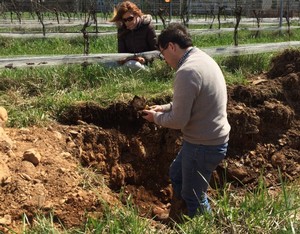
Next year marks 20 years and our decision to plant organic L’Acadie Blanc on these soils has been validated with numerous international sparkling awards. It hasn’t been easy for the vines as they slowly stretched their roots straight down deep through schist, sandstone, slate and gravels. Now they are strongly rooted with symbiotic fungal network filaments that extend their reach for nutrients, making them more resilient to climate change and, more immediately apparent, sourcing and expressing their terroir very clearly. Wine judges have been noticing our flavours especially in organic wine Prestige Brut Estate (PBE) sourced from the same block every year with more topsoil (8 vs 6 inches) and more vigour than other blocks on the property.
Read more about climate change, Climate Change and Nova Scotia Sparkling
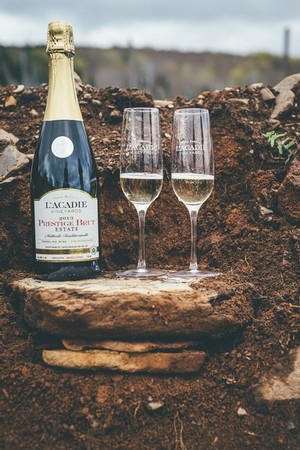
“Open and powerful nose with grilled hazelnut, pineapple, lemon and honey” 2010 PBE, Effervescent du Monde, silver
"A floral, apple nose with chalky lemon and creamy pear on the refreshing, mineral palate." 2013 PBE, Decanter, 92 points
"Complex apple, peach, nut and citrus bouquet with a toasty palate and fine mousse" 2014 PBE, Decanter, 92 points
"Perfumed with rose, white peach and toast; and a bright palate of zesty lime zest and apple." 2015 PBE, Decanter, 88 points
"Pretty and attractive, with white fruit, honey melon, chalky green apple and lifted floral aromatics lead through to a palate of vibrant acidity, citrus curd and a fine, saline finish." 2017 PBE, Decanter, 95 points
Minerality and more focused terms such as electricity, vibrancy and zesty can be used to describe our terroir and as well as an underlying descriptor of slight saline related to ancient seabed origins of our mainly sedimentary rocks. We continue to build the soil and rhizosphere with vegan viticulture inputs of composted grape pomace teeming with microorganisms and humus to nurture topsoil and below. This topsoil on top of rocky profiles is analogous to Champagne’s Grand Cru parcels with their topsoil over chalky soil and provides a living window to the surface contributing crucial elements such as atmospheric nitrogen fixed by clover and other plants in our cover crops.
To say we are excited about the future gifts our vineyard will yield is an understatement. Roots will get deeper and source more flavours, and we have expanded the estate to include new plantings of Chardonnay, Pinot Noir and Sauvignon Blanc, my old friends.
Hybrid vs. vinifera - let's market our region instead
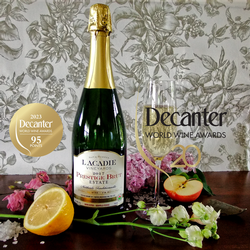
Our wine region is based on hybrid grapes, grape varieties originating from plant breeding programs that blended the winemaking characteristics of European varieties called vinifera with North American varieties known for winter hardiness and disease resistance. An example of vinifera is Chardonnay and a local hybrid is L’Acadie Blanc, Nova Scotia’s signature grape variety. Many hybrid varieties were pulled out in other warmer regions of Canada in the 1980’s and replanted with vinifera, almost all grapes in BC and less in Ontario, and they were known for high cropping and a quality level that suited consumer preferences of the day – I was in BC at this time in my early winemaking career making Hochtaler and Baby Duck. Myth and stigma continues for hybrid grapes but wines in cool climates like our region are high quality from excellent viticulture and turning heads, and we have to learn to market them without making excuses.
L'Acadie Vineyards recently earned a Gold medal and 95 points at Decanter World Wine Awards in London for a 100% L’Acadie Blanc sparkling wine called Prestige Brut Estate. It has been three months since the announcement and our Gaspereau winery is having an enjoyable ride of media coverage and sales. In our favour are competitions such as this prestigious one where the sparkling cartegory is not varietal specific, and tasted blind. After a period of reflection my opinion is that Decanter’s take on the win is similar to when a California wine first won at this prestigious European wine competition in the 1970's, dramatized in the film Bottle Shock. Very much appreciate their words about us, but the focus is tilted towards hybrids,
"Canada is a cool climate region that knows a thing or two about the benefits of hybrid grape varieties, and for the first time a single varietal L’Acadie Blanc, a hybrid crossing of Cascade and Seyve-Villard, was awarded a Gold medal in its rendition as a sparkling wine for L’Acadie Vineyards, Prestige Brut 2017 from Gaspereau Valley in Nova Scotia. A noteworthy first-ever Gold for the region too." Olivia Mason, Decanter June 7, 2023.
They focussed on the "shock" of a hybrid grape winning but isn’t the real news, the “bottle shock”, that Nova Scotia won? Or our winery, our organic wine. It's feeding the myth that hybrids are lesser quality but with notable exceptions like this one bubbling up from the bottom now and then. If a wine from Portugal’s Douro Valley appellation won a similar award would the news be about a relatively obscure regional varietal like Gouveio, Malvasia Fina, Rabigato, and Viosinho or would it simply be the Douro region? I think the latter and much better for marketing the region especially since they rarely label their wines by varietal. And what if a Tidal Bay wine won a big international award? Would the focus be on the hybrid varieties in the blend? Much better marketing for our region would be to promote the appellation brand and Nova Scotia.
How do we change the narrative? Let’s start close to home. I have heard it so many times from wineries in Nova Scotia,
“we have the hybrids pruned and now starting the viniferas”
“how much do you pay for hybrids?”
And more recently, “congratulations on your Decanter gold, especially since it is for a hybrid”
Let’s start talking about varieties as just that, varieties, without categorizing them into a class system. Each variety has unique winter hardiness and disease resistance and we even saw an exception to the myth rule this past winter after the polar vortex - Riesling fared better than hybrid New York Muscat.
There has been much effort to plant vinifera varieties in the last 10 years under the impression that wine trade will take our region more seriously if we produce varietals such as Pinot Noir and Chardonnay. The polar vortex was a sobering call and perhaps it’s time to change our mindset, and change wine trade’s narrative. And there are individuals in wine trade that are already our “freedom riders”,
“I’d rather have a ripe Marechal Foch than an underripe Pinot Noir”, well known local wine lover Jeff Pinhey
"I used to turn my nose up (literally) at North American hybrid grapes as a young and foolish sommelier. Now, I'm putting my money where my mouth is! #lovelacadieblanc !", Kristen Perrin, sommelier


